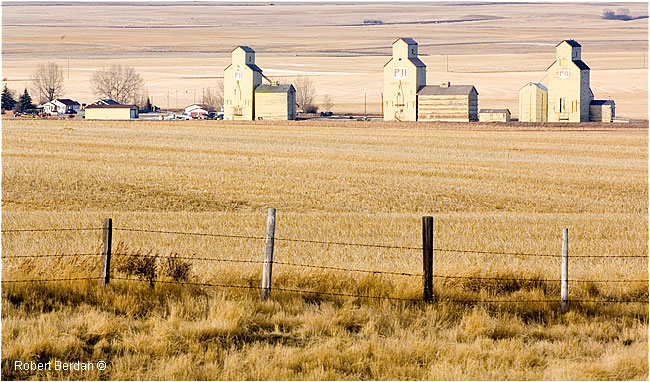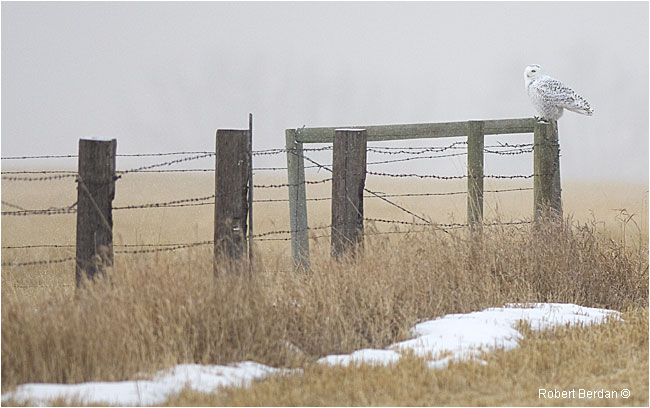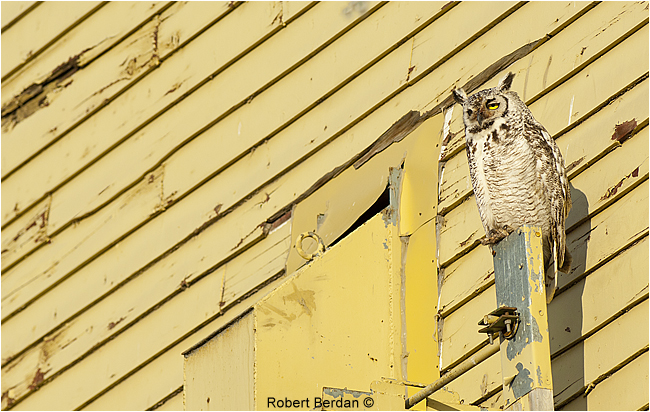
Juvenile Male Snowy Owl - the birds have large yellow eyes which can not move so the owls must turn their heads to
shift their gaze. With 14 neck vertebrae they can turn their head a full 270°.
Snowy owls (Bubo scandiacus) are the second largest owl in Canada the largest being the Great Gray Owl. In winter snowy owls migrate to the wind swept prairies that resemble the wide open spaces of the arctic tundra. These beautiful birds can be photographed east and south of Calgary between November and the end of March. One of my favorite places to photograph snowy owls is near a small town south of Calgary called Mossleigh. The town features three prominent grain elevators, a gas station, two restaurants and a hotel.

Grain Elevators in Mossleigh from Highway 24 , Alberta. I have often spotted snowy owls on the telephone poles and fence posts around Mossleigh. Great horned owls are frequently observed in trees and abandoned homes and barns in the area.
To spot snowy owls you need to stop and get out of your car and scan the fence and telephone poles with binoculars. If the owls are on the ground they are so well camouflaged as to be almost impossible to sight until they take flight or move. Once you find a bird you need to get close without scaring them away. When they are on telephone poles I have found I am often able to drive almost right up to them and photograph them from my car window. If they are on fence poles they seem to be more wary. In order to photograph them you will need a 300 mm telephoto lens (or bigger) if you want to see more than a white spot in your pictures. I generally set my camera to A or Aperture priority, Auto white balance and exposure compensation to +0.5 to +1 F-stop and shoot in RAW mode. I also have my camera shutter set to release priority so it will shoot whether or not the bird is in focus, a requirement if you want to capture birds in flight. I set the ISO speed around 400 during the day as most of my shots of these beautiful birds are done hand held though I will take out my tripod if I can or if the bird seems unperturbed by my presence. Some owls seem to ignore me others may take flight when I approach within 100 meters.

Typical snowy owl country near Mossleigh, Alberta - looking east from the grain elevators. By scanning with my
binoculars I am often able to spot a snowy owl on top of a telephone pole.

Female snowy owls have dark barring on their feathers with white faces and both males and females like to perch on
top of telephone poles and scan the fields for rodents.

Left: Male Snowy owls tend to be almost all white whereas females have distinct black bars on their feathers (CS, DM).
In the Arctic snowy owls feed primarily on lemmings and other small rodents during the breeding season, however they are also opportunistic hunters and their prey includes: hares, muskrats, marmots, squirrels, rabbits, prairie dogs, rats, voles, raccoons, ptarmigan, ducks, geese, ring-necked pheasants, grouse, American coots, grebes, gulls and songbirds. They have also been known to attack cats and small dogs. They hunt from the air by hovering and they also watch for prey from a perch which is often a telephone or fence pole on the prairies. The owls are diurnal though they may sometimes hunt a night.

Snowy owl in mid March on a fence pole east of Calgary off Township road 270.
Finding Snowy Owls
Finding Snowy owls often requires driving for miles along country roads east and south of Calgary between November and March. You can also check whether anyone has sighted one of these birds on various web sites (see below). The owls are territorial and will often stay in one area. In Alberta winter territories are held exclusively by females that defend roughly 1.3 to 5.2 square Km for up to 80 days (Lynch 2007). On one March day I spotted 6 snowy owls east of Calgary near Keoma along highway 566.
If you just take a causal drive in the country on a winter day chances are you won't see one unless you are specifically looking for them. To increase your chances you need to stop frequently and get out of your car and scan the country side with a pair of binoculars.

Telephone poles appear to be a favorite perch for snowy owls though they are also found frequently on fence posts and
occasionally in trees.

This snowy owl allowed me to get within about 100 feet of him before he flew off. Individual owls seem to vary in
their weariness to people.

Snowy owl sitting on fence pole - photographed from the highway. I watched from my car as this one hunted for small
rodents in the field.

Snowy owl perched in a tree - this was as close as I was able to get to it on foot before it flew off. ( 300 mm + 1.4 X teleconverter).

When snowy owls are on the ground they are very difficult to detect unless you see them land or move.

Snowy Owl getting ready to take off - this is when you want to be ready to shoot a burst of photos in an attempt to get some
in flight shots. See my article on photographing birds in flight for more photo tips on photographing birds in flight.

Snowy Owl taking flight in a field near Mossleigh. You need quick reflexes when they decide to fly and most of the time
they fly in a direction away from you.

Snowy owl in flight after taking off from a telephone pole - the telephone pole was removed with Photoshop (DM).
Photographing snowy owls in flight is tricky. You need to anticipate when they might take off. Generally they will lift their wings and lean into the wind. One particular owl near Mossleigh I encountered would not fly away even when I came right under neath him as he was sitting on a telephone pole. After about a half hour and having taken hundreds of photos of him from below I rapped on the telephone pole and he flew to the next pole. The birds fly with a steady flight with strong wing beats interspersed with glides. The snowy owls seem to ignore cars so you can use your vehicle as a blind from which to observe and photograph them (for tips on shooting from your car window see my article on window mounts).

Snowy owl and full moon over the prairie (composite image DM).
Snowy owls have a maximum lifespan of about 10 years in the wild and up to 28 years in captivity. Their population is estimated to be between 10,000 and 30,000 breeding pairs in Canada. Their feet have 4 talons and are thickly feathered to protect the birds when temperatures drop to below -30°C for weeks. When they capture a rabbit the bird sinks its talons into the back and backflaps until the rabbit is exhausted. During the breeding season males will kill and display prey in caches to impress the females.

Deadly talons and thickly feathered feet protect the birds from extreme cold.

Snowy owls have the second largest wingspan of any owl and they are virtually silent during the non-breeding season.

This owl was sitting on the fence surrounding a gas valve near Mossleigh, AB

Snowy owl with full moon coming up behind him. This owl was photographed beside highway 917 south of Strathmore. She was watching voles crossing the highway - a dangerous place to hunt. I was able to walk right up to the pole as large trucks passed by in front of me still she didn't move. I saw voles running across the highway and was concerned the owl might fly down and be hit by a passing truck.
In 1988 the Snowy Owl was printed on the back of Canadian $50 dollar bills and unfortunately in 2006 it was replaced with  picture of a politician. The snowy owl is also the provincial bird of Quebec. The snowy owl is also thought to be one the first bird species that can be identified in Prehistoric Art. Analysis of their mitochondrial DNA suggests snowy owls are closely related to horned owls which are often found in the same habitat during the winter months. picture of a politician. The snowy owl is also the provincial bird of Quebec. The snowy owl is also thought to be one the first bird species that can be identified in Prehistoric Art. Analysis of their mitochondrial DNA suggests snowy owls are closely related to horned owls which are often found in the same habitat during the winter months.
If you would like to photograph snowy owls this winter and you live near Calgary take a drive south to Mossleigh then head up to Strathmore and return via one of the many back roads to Calgary. I use my Southern Alberta Back roads map book for identifying the various roads and find it superior to a GPS which often does not include all the dirt roads. Keep in mind that you probably won't see a snowy owl on every outing and may have to make two or three trips before you do. I have had good luck on foggy days and sunny days so the weather doesn't seem to matter much so long as it's not snowing heavily. Take a long your biggest telephoto lens and some coffee or hot chocolate. If you pass through Mossleigh check out their new restaurants - the Aspen crossing or Mossleigh Bar & Grill. Also stop at the grain elevators and check for Great Horned owls they can sometimes be seen in the elevator windows or on posts in front the elevators. Great Horned owls also frequent abandoned barns and homes on the prairies and can be spotted all year long.

Great horned owl acting as a sentinel in front of the grain elevators in Mossleigh.
Winter is the only time you can photograph snowy owls around Calgary, but don't be disappointed if you don't see one the first time you take a drive into the prairies- they are not easy to spot. On average I see at least one out of every 2 or 3 drives into the prairies east and south of Calgary. I have never yet spotted one in the foothills so I recommend concentrating in the flat open countryside. If you are persistent you will find them. RB

Snowy owl hunting over fields north of Strathmore.

Snowy Owl flying on white sky winter day near Mossleigh - I had stopped to photograph a Horned lark sitting on the fence (barely visible in the back) when this owl flew past. My favorite days to photograph in winter are when the sky is completely white and the horizon seems to blend into the sky - it just feels wintery.
January 1, 2012 - New Years Day Update on Snowy Owls

On Sunday January 1, 2012 - I joined fellow photographers Halle Flygare and Kamal Varma and we photographed 3 snowy owls east of Calgary. They are back, but getting close to them isn't easy - so take your binoculars with you.

Male Snowy Owl on the ground near Mossleigh - Halle spotted him just across the highway from the Crossing Train Restaurant.
Links & Resources on the Web
References
Wayne Lynch (2007) Owls of the United States and Canada. Johns Hopkins. ISBN 0-8018-9687-2 (See my review of Wayne's Owl Book).
James Duncan (2003) Owls of the World. Key Porter Books. ISBN 1-55263-214-8
J.F. McDonald ed. (1993) A Birdfinding Guide to the Calgary Region by Calgary Field Naturalists' Society (One of the best books describing driving routes where you can find certain birds around Calgary). ISBN 0-921224-05-2.
CS captive species, DM digitally manipulated.
[ Top ]
|

